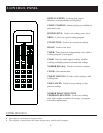
15
COOKING UTENSILS GUIDE (continued)
NOT RECOMMENDED
Glass jars and bottles -- Regular glass is too thin to be used in a microwave. It can shatter and cause
damage and injury.
Paper bags -- These are a fi re hazard, except for popcorn bags that are designed for microwave use.
Styrofoam plates and cups -- These can melt and leave unhealthy reside on food.
Plastic storage and food containers -- Containers such as margarine tubs can melt in the microwave.
Metal utensils -- These can damage your microwave. Remove all metal before cooking.
Note:
Should you wish to check if a dish is safe for microwaving, place the empty dish in the microwave
and microwave on high for 30 seconds. A dish that becomes very hot should not be used.
•
COOKING TECHNIQUES
Your microwave makes cooking easier than conventional cooking, provided you keep these
considerations in mind:
STIRRING
Stir foods such as casseroles and vegetables while cooking to distribute heat evenly.
Food at the outside of the dish absorbs more energy and heats quicker, so stir from the outside to the
center.
The microwave will turn off when you open the door to stir your food.
•
•
•
ARRANGEMENT
Arrange evenly shaped foods, such as chicken pieces or chops, with the thicker, meatier parts
towards the outside of the turntable where they receive more microwave energy.
To prevent overcooking, place delicate areas, such as asparagus tips, towards the center of the
turntable.
•
•


















